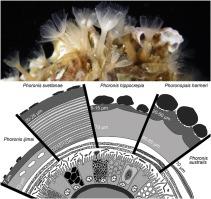Our official English website, www.x-mol.net, welcomes your feedback! (Note: you will need to create a separate account there.)
First data on the structure of tubes formed by phoronids
Zoology ( IF 2 ) Pub Date : 2020-12-01 , DOI: 10.1016/j.zool.2020.125849 Elena Temereva , Tatiana Shcherbakova , Alexander Tzetlin
Zoology ( IF 2 ) Pub Date : 2020-12-01 , DOI: 10.1016/j.zool.2020.125849 Elena Temereva , Tatiana Shcherbakova , Alexander Tzetlin

|
Phoronids are marine benthic animals that live in tubes in soft sediment or hard substrata; the phoronids form the tubes by digging or boring. Epidermal glands produce much of the material of the tube, which is completely imbedded in the soft sediment or hard substrata. The structure of phoronid tubes has not been previously studied in detail. In the current research, the morphology and microstructure of the tubes were studied by light microscopy, histology, and scanning electron microscopy for the following species: Phoronis ijimai, Phoronis svetlanae, Phoronis hipporcrepia, Phoronis australis, and Phoronopsis harmeri. In most of these species, the tube consists of an inner organic cylinder and an external layer. The inner organic cylinder is formed by three layers (inner, middle, and outer) of thin films. Each film is formed by fibers, whose thickness differs in different species. These fibers form a net, whose density is higher in digging phoronids than in boring phoronids. The middle layer is formed by highly compressed thin films. The outer layer is the densest portion of the inner cylinder and is associated with the external layer. The external layer is absent in some species (P. australis) but is well developed in digging phoronids. The differences in the organization of tube are consistent with the biology of each species and depend on the type of substrata and on the life style of the animal. Tube organization substantially differs between phoronids and sedentary annelids: the inner organic cylinder is much thicker in phoronid than in annelid tubes, and the fibers that form films are randomly oriented in phoronids but regularly oriented in annelids. In annelids but not in phoronids, inorganic particles in the external layer are usually surrounded and glued together by organic material. These differences may be used to distinguish phoronid tubes from annelid tubes in present-day benthic samples and also in fossil samples.
中文翻译:

关于由佛罗尼虫形成的管子结构的第一批数据
Phoronids 是海洋底栖动物,生活在软沉积物或硬质基质中的管子中;phoronids 通过挖掘或钻孔形成管子。表皮腺产生管子的大部分物质,这些物质完全嵌入软沉积物或硬质基质中。phoronid 管的结构以前没有详细研究过。在目前的研究中,通过光学显微镜、组织学和扫描电子显微镜研究了以下物种的管的形态和微观结构:Phoronis ijimai、Phoronis svetlanae、Phoronis hipporcrepia、Phoronis australis 和 Phoronopsisharmeri。在大多数这些物种中,管由内部有机圆柱体和外层组成。内部有机圆柱体由三层(内、中、外)薄膜构成。每一个薄膜都是由纤维形成的,其厚度因物种而异。这些纤维形成一个网,其密度在挖掘 phoronids 中比在钻孔 phoronids 中更高。中间层由高度压缩的薄膜形成。外层是内圆柱体最致密的部分,并与外层相关联。外层在某些物种(P. australis)中不存在,但在挖掘 phoronids 中发育良好。管组织的差异与每个物种的生物学一致,并取决于基质类型和动物的生活方式。phoronids 和久坐的环节动物之间的管组织有很大不同:phoronid 的内部有机圆柱体比环节动物的管厚得多,形成薄膜的纤维在 phoronids 中随机取向,但在环节动物中定向。在环节动物中而不是在佛龙类中,外层中的无机颗粒通常被有机材料包围并粘合在一起。这些差异可用于区分现今底栖样本和化石样本中的 phoronid 管和环节动物管。
更新日期:2020-12-01
中文翻译:

关于由佛罗尼虫形成的管子结构的第一批数据
Phoronids 是海洋底栖动物,生活在软沉积物或硬质基质中的管子中;phoronids 通过挖掘或钻孔形成管子。表皮腺产生管子的大部分物质,这些物质完全嵌入软沉积物或硬质基质中。phoronid 管的结构以前没有详细研究过。在目前的研究中,通过光学显微镜、组织学和扫描电子显微镜研究了以下物种的管的形态和微观结构:Phoronis ijimai、Phoronis svetlanae、Phoronis hipporcrepia、Phoronis australis 和 Phoronopsisharmeri。在大多数这些物种中,管由内部有机圆柱体和外层组成。内部有机圆柱体由三层(内、中、外)薄膜构成。每一个薄膜都是由纤维形成的,其厚度因物种而异。这些纤维形成一个网,其密度在挖掘 phoronids 中比在钻孔 phoronids 中更高。中间层由高度压缩的薄膜形成。外层是内圆柱体最致密的部分,并与外层相关联。外层在某些物种(P. australis)中不存在,但在挖掘 phoronids 中发育良好。管组织的差异与每个物种的生物学一致,并取决于基质类型和动物的生活方式。phoronids 和久坐的环节动物之间的管组织有很大不同:phoronid 的内部有机圆柱体比环节动物的管厚得多,形成薄膜的纤维在 phoronids 中随机取向,但在环节动物中定向。在环节动物中而不是在佛龙类中,外层中的无机颗粒通常被有机材料包围并粘合在一起。这些差异可用于区分现今底栖样本和化石样本中的 phoronid 管和环节动物管。


























 京公网安备 11010802027423号
京公网安备 11010802027423号